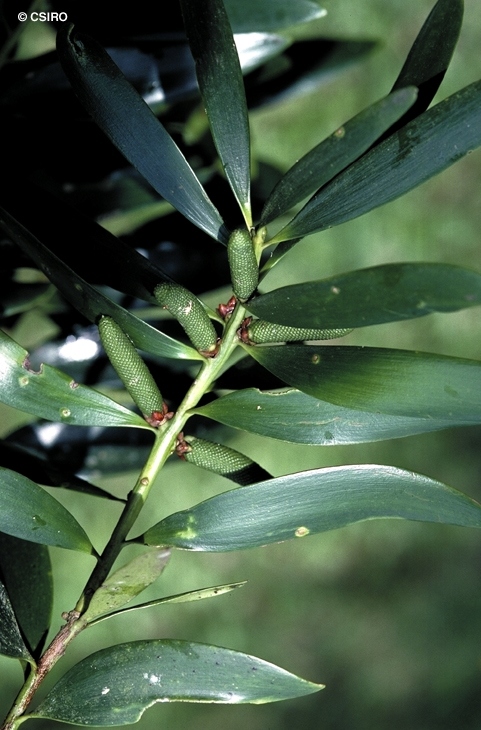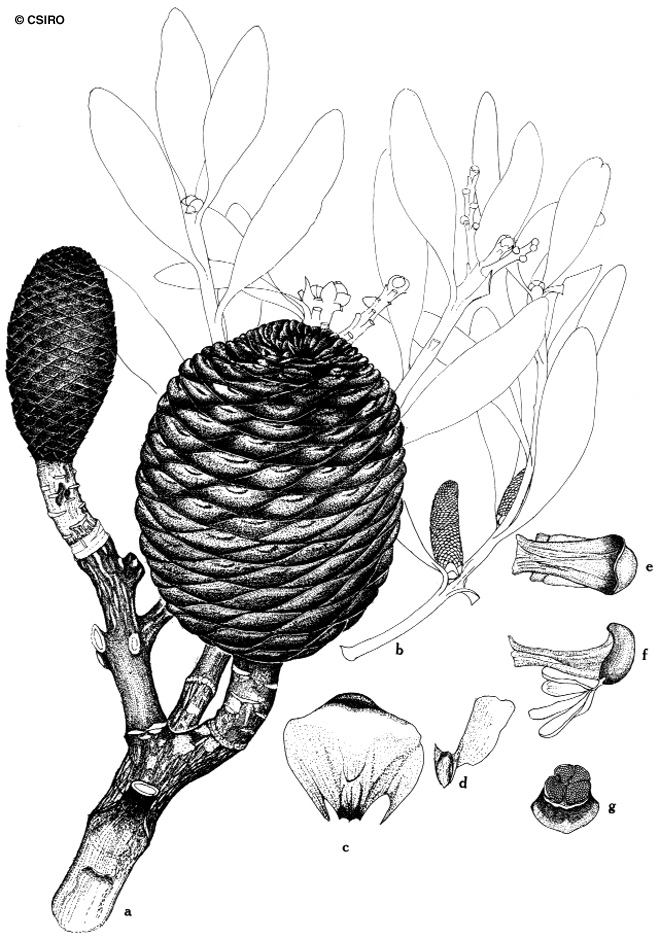Australian Tropical Rainforest Plants - Online edition
Agathis robusta (C.Moore ex F.Muell.) F.M.Bailey







Bailey, F.M. (1883) A Synopsis of the Queensland Flora : 498.
Kauri Pine; South Queensland Kauri Pine; South Queensland Kauri; Smooth Bark Kauri; Queensland Kauri; Queensland Kauri Pine; Pine, Kauri; Pine, Dundathu; Pine, Queensland Kauri; North Queensland Kauri Pine; North Queensland Kauri; Kauri, North Queensland; Kauri; Dundathu Pine; Kauri, South Queensland
Bark brown to grey, smooth, except for scattered flakes. Stem completely lacking buttresses. Exudate slow and meagre.
Leaf blades about 5-13 x 1-4 cm. Veins fine and close, running lengthwise and +/- parallel to the edge of the leaf blade.
Male cones about 4-10 cm long with more than 500 scales per cone, generally persisting on the ground beneath mature trees. Female cones with about 340-440 scales per cone. Scales about 3.4-3.9-4.1-4.6 cm.
Cones about 8-10.5 cm diameter each with about 340-440 scales per cone.
Cotyledons lanceolate with a number of veins arising at the same point at the base and continuing +/- parallel to the apex. Cataphylls are produced above the cotyledons and after lateral shoots are produced. At the tenth leaf stage: seedling glabrous. Seed germination time 5 to 7 days.
Endemic to Queensland, widespread in NEQ with another occurrence in the south-eastern corner of Queensland but absent from coastal central Queensland. Altitudinal range in NEQ from near sea level to 1100 m. A characteristic tree of drier rain forest where other tree species experience difficulty in attaining large dimensions. The presence of the species triggered the construction of access roads to a number of North Queensland localities, e.g. Kirrama, Windsor Tableland and perhaps even the earlier settlements like Danbulla on the Barron River. A. robusta ssp. nesophila occurs in New Guinea.
This was the most common species of the Kauri Pine in North Queensland and one of the first stands to be exploited was in the Barron River catchment. The stands in the Danbulla State Forest area were particularly sought after because of their timber potential. Even in the 1920's and 1930's conflicts occurred between those who sought to exploit these stands and those who sought to protect them. The Forestry Department of the day imposed girth limits to protect the growing stock from industry. These efforts were not always successful and accounts of ring barking episodes on moonlight nights abound. These accounts appear to be based on fact and as a result the Forestry Department was forced to allow the logging of trees which would otherwise die and rot in the forest. Accounts of poisoning persisted right up to until the 1950's but are harder to substantiate. By then the Forestry Department had taken a harder line and refused to allow logging of trees suspected of being victims of poisoning. Agathis robusta also occurred in good stands on the Kirrama Range and most of this area was logged during the second world war. It was a valuable resource largely consumed by the war effort. The last significant stand of Agathis robusta to be logged was on the Windsor Tableland and this was exploited in the 1970's and 1980's. Kauri Pine contributed much of the folklore of North Queensland but not to the same extent as in New Zealand. When most of the logs were being shipped out of Cairns and when the only reliable transport of logs to Cairns was by rail, an upper size limit had to be set on logs (mainly Kauri Pine logs) so that the rail wagons would fit through the tunnels on the Kuranda Range. This limit was set at 22 feet girth.
The timber of this species has had a wide range of uses and more or less corresponds with those of Araucaria cunninghamii.
Wood specific gravity 0.48. Cause et al. (1989).





